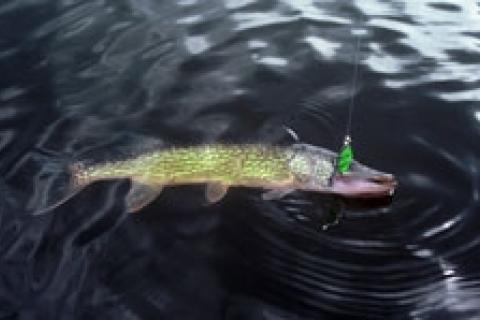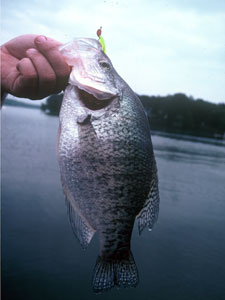
Vertical jigging always seems like a rather peculiar fishing technique when you first come upon people using it. Hunkered in the bow of a boat, moving just their forearms, the anglers do not cast. They do not reel. They simply twitch their rod tips up and down — rhythmically, hypnotically.
 |
| Crappies respond well to vertically jigged lures. |
It may look boring. But it's not. The reason is that during winter months, vertical jigging is one of the deadliest fishing tactics you can use. If you had any question about that, just think about all the thousands of anglers who live in the far north where lakes freeze during winter. They catch millions of fish by jigging their lures straight up and down through holes in the ice. The same tactics that work on those frozen lakes also produce on open water.
Several reasons account for this method's effectiveness. It puts the lure directly in front of the quarry at exactly the level fish are located at. And it keeps it there, dancing seductively in front of the fish's face. This duplicates the appearance of a shad or minnow struggling, trying to right itself, yet failing to do so and fluttering helplessly.
Not only does the offering stay in the strike zone, but the lazy, rhythmic up-and-down motion makes it easy for the quarry to catch compared to a lure that is cast out and pulled quickly past them on a traditional retrieve. This is particularly important during winter, when a fish's metabolism is slow and it's not anxious to chase a fast-moving lure wiggling through its territory.
Vertical jigging also appeals to a wide variety of fish-virtually anything that swims. I remember the first time I was shown this technique many years ago. The guide on Santee-Cooper in South Carolina jigged up a 3 pound largemouth, then a 2 pounder. After that he pulled up a white bass, followed by a slab-sided crappie.
I quickly became a convert to vertical jigging. But I found out as I worked on the technique that it wasn't quite as simple as it might look. Often, in fact, it's the most sophisticated anglers on the water who turn to this simple-looking angling method.
While it can work any time of year, winter is made for vertical jigging. Fish concentrate in deep water now, typically at depths of 12-50 feet. That's the range where vertical jigging is most productive. At shallower depths, you tend to spook the quarry when you position your boat directly over it.
You can probably catch anything vertically jigging, but among the species I've personally taken are largemouths, spotted bass, smallmouths, stripers, hybrids, sauger, walleye, pickerel, yellow perch, white perch, white bass, bluegills, salmon, brown trout, brookies, rainbows, catfish, white shad, hickory shad and a variety of saltwater species. This makes the technique especially exciting. You never know what will strike the next time you jig your lure and let it flutter down.
Before using this tactic, you need to locate a prime location. Two approaches work. You can simply find good underwater structure that might hold fish and start jigging, or better still, find bait and possibly gamefish holding on that cover with your depth finder.
The first step is to locate a good area to try. That can mean bridge pilings, sharp drop-offs, river channel edges, deep points, submerged islands, humps, flooded road beds, underwater springs, standing timber or holes deeper than the surrounding water. You can locate some of this on a topographic map before going out, and then pinpoint it with your sonar. At times it can pay to throw out marker buoys, to be sure you remain on the best spot as you jig it.
Also try to find both forage and game fish on the depth finder if possible. If you know a spot is consistently good in winter, this isn't absolutely necessary. Fish can swim in and out of a location. But it helps if you pinpoint activity there.
Look for bait anywhere from 5-40 feet deep, gamefish typically 5-10 feet below them. Spinning tackle will work for vertical jigging, but baitcast gear is ideal, since it allows more direct lure contact. Use a stiff graphite rod of 5 1/2-7 feet with line testing 6-30 pounds, depending on the size of fish present, the size lure you're using and the number of snags present.
Lures
If you were only allowed one lure for vertical jigging, it would have to be the "slab" type spoon. These lures come in weights ranging from 1/16 to 4 ounces or more. They are narrow, flat spoons with little curve in their design. But they flutter enticingly when jigged up and allowed to drop back freely without tension on the line.
 |
| The best lure of all for vertical jigging in most situations is the slab spoon. |
For panfish and small trout, choose models in the 1/16-1/4 ounce size. For larger bass, walleyes, pickerel, saugers and hybrids, spoons in the 1/2 to 3/4 ounce range are best. For stripers or saltwater gamefish, use 1-4 ounce versions. The Hopkins is one of the most famous slab spoons, but many companies make their versions and most are very effective.
Blade lures are also excellent for vertical jigging. These heavy, slender metal lures are shaped something like a thin slab spoon, but feature weight distribution and line-tie holes that allow their minnow-shaped bodies to maintain a normal upright swimming posture as you pump them up and down.
Vibrators or lipless crankbaits are also good choices. These include the Cotton Cordell Super Spot, Bill Lewis' Rat-L-Trap, Rattlin' Rapala and others. Choose 1/4 ounce versions for panfish, 1/2-1 ounce sizes for larger gamefish. The jigging Rapala plug was developed for ice fishing, but anglers have discovered this can be deadly on open water bass as well when vertically jigged. Stripers, walleyes and saugers also like that one.
Jig/Spinner Combos can be good, as can regular jigs such as bucktails or plastic-tailed grubs. Finally, don't overlook tailspinners such as the Mann's Little George. These lures have a heavy minnow-type body and spinner on the trailing extension shaft.
How to Fish Them
After you've found a good piece of cover, hopefully with some bait and gamefish showing on or near it, it's time to put your lure into action. Push the free-spool button and lower the lure straight down to the fish. You can either drop it all the way to the bottom and then raise the lure up to the appropriate level, or measure the line as you lower the lure. One easy way to do this is to determine how much line goes out with each side to side movement of the line guide on the reel and count it down. Alternately, you can measure the distance between your reel and the first rod guide and strip line out manually, say 2 feet at a time.
 |
| Pickerel in deep water can be jigged up on spoons and lipless crankbaits in winter. |
The jigging motion you use can vary widely depending on the mood of the fish, the species you're going after and weather conditions. Try not to get stuck in a rut. One day a jerking rod movement of 3-4 feet may produce. Other times simply twitching the tip a few inches at a time is best. Most of the time, I'll go with a 12-18 inch jigging motion.
Crappies are different than most species. They don't require much rod movement at all. Just the quivering of your hand as you try to hold the lure steadily can sometimes draw strikes. I theorize that this looks like a fish rotating its pectoral fins nervously.
For fish other than crappies, raise the rod sharply, but drop it down just fast enough so the lure sinks freely. If you lower the rod tip too quickly and slack forms, you may miss strikes. If you lower the rod too slowly, it constrains the lure's fall and it won't have that alive, fluttering appearance that entices fish to nab it.
Low-stretch lines work better for this fishing than monofilament in most cases, allowing you to sense strikes better. If you feel even the slightest tap on the line or if it stops falling or moves sideways, set the hook.
While fishing a particular piece of structure is the main way to use vertical jigging, it can also produce over a broader area. Drift or use a trolling motor on slow speed if the fish might be spread out, jigging as you go. Drop a buoy over if you connect, then re-drift through that area. If you're fishing a specific piece of structure, give it about 10-15 minutes, then move to a new spot. If you catch a few fish and things turn cold, leave the spot and come back later after resting it for a while.
Some veteran vertical jiggers mark two or three spots with buoys, then return to the first one and start fishing. This lets them sneak in quietly with the electric motor when they return and approach fish that have been rested after the commotion of finding and marking the cover.
Vertical jigging certainly isn't the only tactic you should try in winter. But it definitely is one you should keep in your arsenal of tricks for a cold day on the water.
|
Tips
|
- 7073 views

